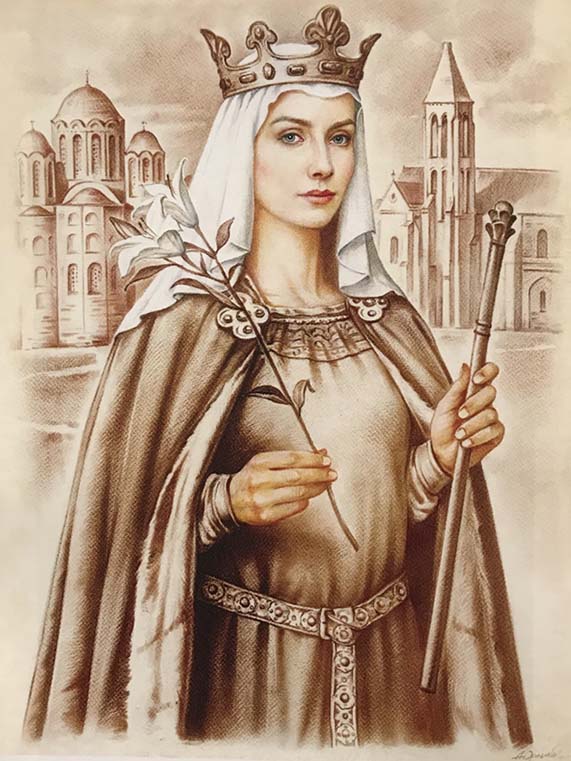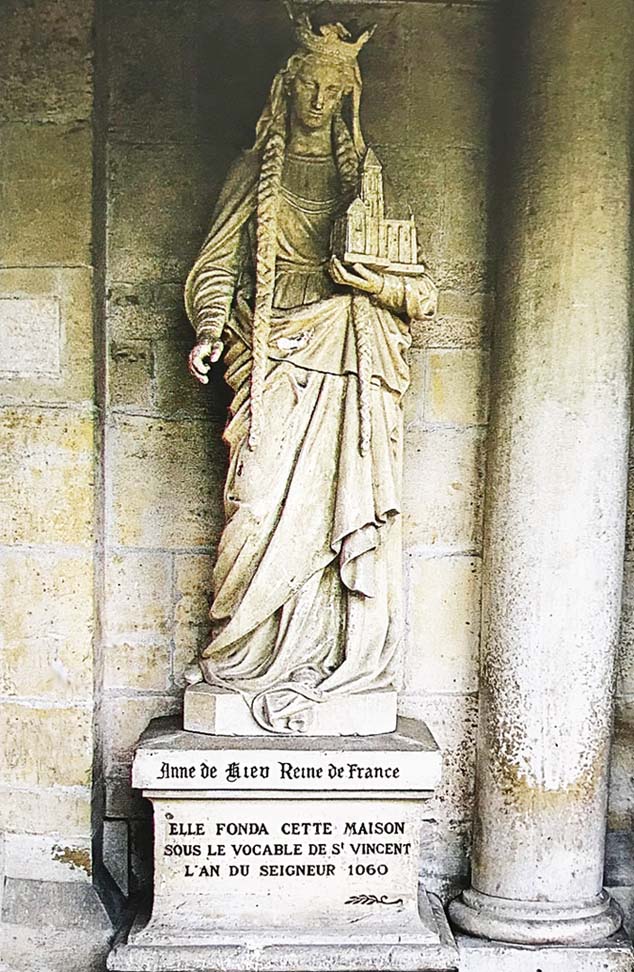Fig. Anna Yaroslavna. Artist A. Orlonov, 2019
The majority of the scientists consider that Anna (1028/1032 – after 1075) was the middle daughter of Grand Prince Yaroslav the Wise of Kyiv and Ingegerd, daughter of King Olof Skötkunung of Sweden. The others are of the opinion that Anna was the youngest daughter of the couple.
There are evidences that Grand Prince Yaroslav was planning to arrange the marriage of Anna to Henry III called the Black, the German king, intending Holy Roman Emperor, since the leader of the Kyiv state aimed at alliancing and friendship with Germany at the very beginning of his ruling. Around 1043, Grand Prince Yaroslav sent the embassy to this king. This fact is recorded in Annales of Lambert (Lampert) von Hersfeld. However, from the unknown reasons, the marriage with the Kyiv Princess was not agreed and the king married to the French bride from Duché d'Aquitaine (Duchy of Aquitaine). Quite possible that the unsuccessful engagement spread the news of the “vacant” princess of Kyiv to be known in France.
François Eudes de Mézeray claims that in 1044, Henry I, the King of France, sent the embassy to Kyiv for conveying the marriage proposal. N. Karamzin assumes that the French marriage-makers arrived in Kyiv in 1048. The other historians attribute this event to 1049 or 1050.
The reason why the bride was sought so far away from France was obviously a complex one. Firstly, the Kyiv state in the 11th century was influential in Europe. It was mighty in terms of political relations, armed forces, richness and cultural development. The influence of Rus on the European politics was beyond any doubt. The French scientists consider that taking into account the long history of Rus dynasty, the marriage as the seal was able to signify the political alliance between the states.
Rus was connected by the close matrimonial tights with the most powerful dynasties of Europe, including Byzantine Imperial Family, which relations the Capétien (Capetian) dynasty wanted to gain. Moreover, the fame and glory of Grand Prince Yaroslav’s daughter as “extremely beautiful, brought up in Christian chastity, educated and possessing deep mind” could spread far beyond the borders of the Kyiv state. The beauty of the bride and the glory of her state were the main reasons for the marriage-making.
There are the researchers who consider that the wedding was in 1049, the others are sure that it took place in 1051. The latter date seems to be more justified. Most likely, that the wedding was on Easter (31 March) or on Pentecost (19 May). According to “Vita Sancti Lietberti”(The Life of St. Lietber) (around 1100), Anna Yaroslavna was the first queen married to the representative of the Capétien dynasty, who celebrated her marriage and was crowned in the Reims Cathedral, the residence of the French church.
Anna had performed the main duty of the queen: saving the dynasty from the decay by giving the birth of three sons to her husband Henry I. “Philip I, who reigned after his father, Robert, who died when he was young, Hugues le Grand (Hugh the Great), later the progenitor of the Vermandois royal family”.
The French historiography with references to the historic sources mentions their daughter Emma born around 1055/1058.
Philip I, the son of Anne de Kiev and Henry I, was the eldest son in the family and the heir of the French throne. Following the tradition established by the predecessors, Philip was crowned at the age of 7, in 1059, when his father was still alive, therefore he and his heirs obtained the right of succession. In 1060, on the death of Henry I, young Philip came to the throne. While Philip was a child, Baldwin V (the husband of the sister of Henry I), Count of Flanders and Queen Anna exercised the regency. Some of the famous historians claim that the queen Anna was initially appointed to be a regent and “it was she who assigned Baldwin V (1067) in charge”. According to the traditions of the Medieval Age, in general, and the Capétien House, in particular, the dowager queen, the mother of the male heir, became the regent of the young king until he came to the age. Anna was a co-regent while Philip was a child and acted as the ruler of the state. During many years Anna was the adviser of young king Philip and actually ruled the country together with the son.
Many landmarks belonging to the cultural heritage of France are directly related to the life of Anne de Kiev and her family as the places of coronation, wedding and burying. Thus, “Vita Sancti Lietberti” witnesses that the Notre-Dame de Reims as the place where the crowning and the wedding of Anna took place. The Basilica of Saint-Denis is the place where Henry I was buried and many of his descendants (this started from his grandson Louis VІ).
A special group among the cultural heritage landmarks could be distinguished as those which were founded and enjoyed the beneficent support of the royal family, its members and Anna Yaroslavna personally. Such deeds are the evidences of the Christian values that Queen Anna and her descendents believed during the life. Namely, there are the monastic buildings, which were founded or re-established by Anna Yaroslavna and her family: Abbaye Saint-Nicaise de Reims, Abbaye Saint-Martin-des-Champs, Abbaye Saint-Vincent de Senlis.
In summer 1061, Anna married to Count Raoul III of Valois but continued to be the active participant of the state life as many of the royal documents witness. One of such documents even contains the original signature of Anna.
The scientists consider that the intending queen left her personal signature on the walls of Saint Sophia Cathedral in Kyiv before her departure to France.
After Raoul’s death in 1074, Anna most likely returned to Philip’s court. There are the records on that the Queen resided in the monastery of Saint-Vincent de Senlis, founded by her. But there is no trustworthy information about Anna and her destiny after 1075.
Anna’s children were brought up in respect to the Christian values and became the true followers of their parents in terms of establishing church foundations and beneficent support for the churches and the monasteries. Hugues, the youngest son of the royal family, became the leader of the First Crusade but died struggling for the Christian shrines far from his Motherland. Emma, the daughter of Anne de Kiev and Henty I, devoted her life to God worshipping and praying, she lived the ascetic life of a hermit and a healer, gaining the fame of Edigna, the patroness saint of Bavaria.
The reigning of Philip I was surprisingly long – 48 years. His state was gradually growing strong: Philip I joined the territories of Vexin and Bourges to his ownership, made Paris the main residence and continued its building.
Olena Kovalenko
Our advice to read:
Сегеда С.П. Видатні жінки української історії: біографічні нариси на тлі історичних подій. Кн. 1. Х–ХVІІІ ст.– Київ: Балтія-Друк, 2020.– 260 с.: кольор. іл.
Соколовський В. Анна. Дилогія, або Біла Королева.– Київ: Видавець Бихун В.Ю., 2018.– 264 с.
Чемерис В. Анна Київська.– Харків: Фоліо, 2016.– 512 с.
Ясинецька О.А. Три покоління благовірності: Інгігерда Шведська, Анна Київська, Едігна Баварська (ХІ – поч. ХІІ ст.).– Дніпро: Тов з ІІ «Типографія «України», 2021. – 152 с.















